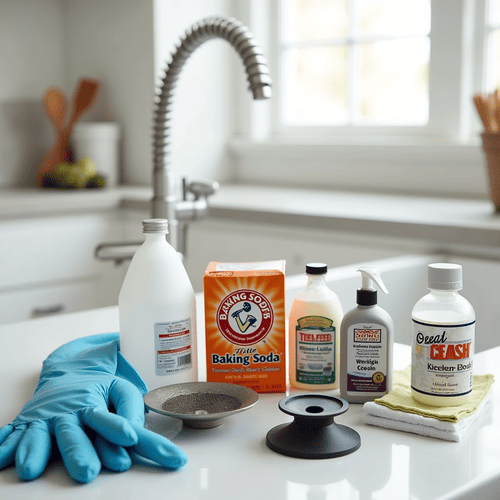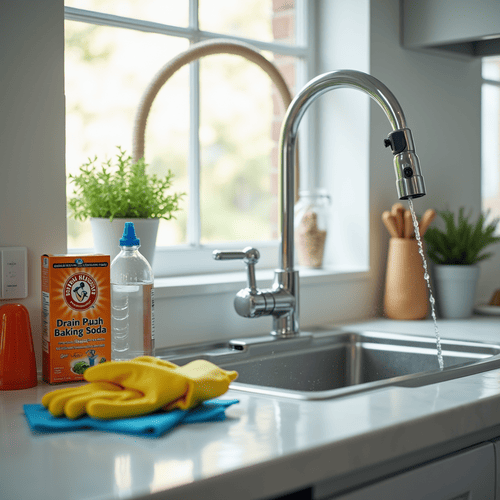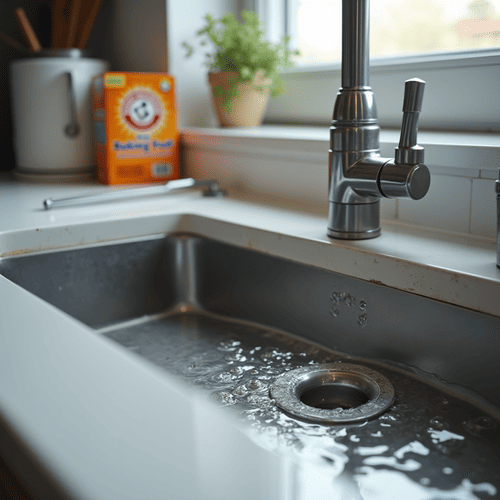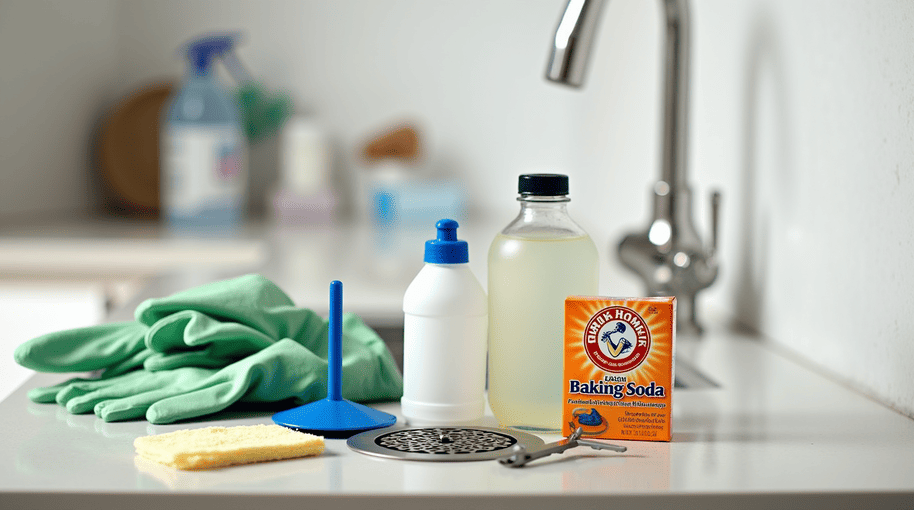How to clean a kitchen sink drain may not be the most glamorous topic, but it’s an essential task for maintaining a healthy and functional kitchen. Over time, your sink drain can accumulate grease, food particles, and other debris that not only lead to unpleasant odors but can also cause stubborn clogs. A clean kitchen sink drain is key to ensuring smooth water flow and keeping your kitchen environment fresh and hygienic.
Ignoring a dirty or clogged drain can result in bigger problems like slow drainage, lingering smells, or even costly plumbing repairs. Fortunately, with the right tools, a bit of know-how, and a few simple steps, you can keep your kitchen sink drain in top shape without much effort.
In this guide, we’ll explore the signs that your drain needs cleaning, tools and materials you’ll need, and a step-by-step approach to tackling dirt and clogs effectively. Whether you’re dealing with a minor blockage or just want to maintain a sparkling clean sink, we’ve got you covered. Let’s dive in and learn how to keep your kitchen sink drain fresh, clean, and clog-free!
Table of Contents
Signs Your Kitchen Sink Drain Needs Cleaning
Understanding when it’s time for kitchen sink drain cleaning can save you from bigger issues like stubborn clogs or costly plumbing repairs. Your kitchen sink is one of the most frequently used fixtures in your home, and it’s easy for food particles, grease, and soap scum to build up over time. Recognizing the warning signs early allows you to take action before the situation worsens.
1. Slow Drainage
One of the first signs you may need to unclog your kitchen sink drain is when water begins to drain slowly. This typically happens when grease, food scraps, or other debris partially block the pipes. If left unaddressed, the blockage can grow, leading to a completely clogged drain.
2. Persistent Odors
A foul smell coming from your sink is another clear indicator that your drain needs attention. Over time, food particles and organic matter trapped in the drain can decay, causing unpleasant odors to waft up into your kitchen. Regular kitchen sink drain cleaning can help prevent these smells from becoming an ongoing problem.
3. Gurgling or Strange Noises
If you hear gurgling or bubbling sounds when water is draining, it may be due to air trapped in the pipes caused by a partial clog. These noises are often a precursor to more significant drainage issues and signal the need to unclog your kitchen sink drain promptly.
4. Water Backing Up into the Sink
Water pooling in the sink or backing up when you use the faucet is a more severe warning sign. This indicates a major blockage in your drain or pipes that requires immediate attention. At this stage, simple cleaning methods may not suffice, and you may need more robust tools or professional help.
5. Visible Residue Around the Drain
Grease, soap scum, or food residue visible around the drain opening is another red flag. This residue not only contributes to clogs but can also harbor bacteria, making your sink less hygienic. Regular cleaning prevents buildup and keeps your kitchen sink sanitary.
By paying attention to these signs, you can address minor issues before they escalate into larger problems. Incorporating regular kitchen sink drain cleaning into your routine ensures a fresh, clog-free sink that functions smoothly.
Essential Tools and Materials for Cleaning Your Sink Drain

When it comes to effective kitchen sink drain cleaning, having the right tools and materials at your disposal is crucial. Whether you’re dealing with a mild odor or a stubborn clog, these essentials make the process smoother and more efficient. Using the right equipment ensures you can unclog kitchen sink drain safely while avoiding damage to your plumbing system. Here’s a list of tools and materials you’ll need, along with their uses.
1. Rubber Gloves
Cleaning a sink drain often involves dealing with debris, grease, and unpleasant odors. A sturdy pair of rubber gloves protects your hands from grime and bacteria, ensuring a hygienic cleaning process.
2. Drain Snake
A drain snake is a highly effective tool for tackling stubborn clogs deep within the pipes. This flexible, coiled device can navigate through curves in your plumbing to dislodge debris like food particles, grease, or hair. It’s an essential item for anyone aiming to handle tough clogs without professional assistance.
3. Baking Soda and Vinegar
This natural cleaning duo is a go-to solution for kitchen sink drain cleaning. Baking soda works as a gentle abrasive, while vinegar’s acidity helps break down grease and other residues. Together, they create a fizzing reaction that can effectively clear minor clogs and eliminate odors.
4. Hot Water
Hot water is a simple yet powerful ally for keeping your drain clean. It helps dissolve grease and flush out loosened debris after using other cleaning methods. Regularly flushing your drain with hot water can also prevent future build-up.
5. Sink Stopper or Drain Cover
A sink stopper or drain cover is essential for regular maintenance. These items prevent large food particles and debris from entering the drain in the first place, reducing the risk of clogs.
6. Plunger
A small plunger specifically designed for sinks can help dislodge blockages near the surface. By creating suction and pressure, it can be an effective first step to unclog kitchen sink drain without the need for more advanced tools.
7. Mild Dish Soap
For regular maintenance, a few drops of dish soap combined with hot water can work wonders. It helps break down grease build-up and keeps your sink drain fresh and clean.
8. Chemical Drain Cleaner (Optional)
While not ideal for regular use due to potential damage to pipes, a chemical drain cleaner can be a last-resort solution for severe clogs. Always follow the instructions carefully and avoid using harsh chemicals excessively.
9. Bucket or Container
A bucket can be helpful for collecting water or debris when cleaning the sink trap or handling messy clogs.
By equipping yourself with these tools and materials, you’ll be well-prepared for any kitchen sink drain cleaning task. Whether you prefer natural remedies like baking soda and vinegar or more advanced solutions like a drain snake, these essentials cover everything you need to maintain a clean, clog-free drain.
RELATED : 7 Powerful Steps to Clean Oven Using Baking Soda Naturally
How to Clean a Kitchen Sink Drain Step by Step

Regular maintenance and proper techniques are key to keeping your kitchen drain free from clogs, odors, and buildup. This step-by-step guide will walk you through effective methods for kitchen sink drain cleaning using simple tools and techniques. Whether you’re dealing with a stubborn blockage or just want to maintain a fresh and functional sink, these steps have you covered.
1. Preparing Your Sink for Cleaning
Before you start, gather all the tools and materials you’ll need for the task, such as rubber gloves, a drain snake, baking soda, vinegar, and hot water. Start by:
- Removing any large food particles or debris from the sink.
- Taking out the sink stopper or drain cover to allow easy access to the drain.
- Flushing the sink with hot water to loosen any grease or buildup inside the pipes.
2. Using Baking Soda and Vinegar for Natural Cleaning
One of the most popular and effective methods for unclogging kitchen sink drains involves baking soda and vinegar. Here’s how to do it:
- Directly pour one cup of baking soda down the drain.
- Follow it with 1 cup of white vinegar. The interaction of the two substances will cause a fizzing response.
- Allow the mixture to sit for 15–20 minutes to break down grease and residue.
- To remove the loose particles, flush the drain with hot water.
This natural solution is ideal for regular cleaning and is safe for most plumbing systems.
3. Using a Drain Snake for Stubborn Clogs
For tougher clogs, a drain snake is your best bet. Follow these steps:
- Insert the drain snake into the drain opening and push it down slowly until you feel resistance.
- Rotate the snake to grab or break up the blockage.
- Gently pull the snake back out, removing any trapped debris.
- Rinse the drain thoroughly with hot water to ensure the clog is completely cleared.
This method works well for blockages caused by grease, food particles, or hair.
4. Flushing the Drain with Hot Water
After using any cleaning method, flushing the drain with hot water is essential to remove remaining debris and residue. Bring a saucepan of water to a boil, then slowly and steadily pour it down the drain. This step not only clears the pipes but also helps dissolve grease and soap scum.
5. Using a Sink Plunger for Surface Blockages
If the blockage is closer to the surface, a small sink plunger can help:
- Pour a little water into the sink to form a seal.
- After placing the plunger over the drain, firmly press down and swiftly draw up.
- To remove the obstruction, repeat this action multiple times.
The suction and pressure should help move the debris through the pipes.
6. Cleaning the Sink Trap
If the above methods don’t work, it might be time to clean the sink trap. Here’s how:
- To collect any water or debris, place a bucket underneath the trap.
- Unscrew the trap carefully and remove it.
- Clean out the trap using hot water, dish soap, or a brush.
- Reassemble the trap and test the drain by running water through it.
7. When to Use Chemical Drain Cleaners
For severe clogs that resist natural methods, a chemical drain cleaner may be necessary. Follow these precautions:
- Select a product that works with the plumbing system you have.
- Read and follow the manufacturer’s instructions carefully.
- Avoid using chemical cleaners frequently, as they can damage pipes over time.
By following this step-by-step guide, you can tackle any kitchen sink drain cleaning task efficiently. Whether you prefer natural remedies like baking soda and vinegar or tools like a drain snake, these methods will help keep your drain fresh, functional, and clog-free.
Additional Tips to Keep Your Kitchen Sink Drain Fresh

A clean and well-maintained kitchen sink drain is essential for preventing clogs, eliminating odors, and ensuring smooth water flow. Beyond occasional deep cleaning, incorporating simple daily habits and preventive measures can help maintain your sink’s freshness and functionality. Here are some practical tips for ongoing kitchen sink drain cleaning and maintenance to keep your sink in top shape.
1. Avoid Pouring Grease Down the Drain
Grease accumulation is one of the most frequent reasons for obstructions. Hot grease may flow easily down the drain but will solidify as it cools, creating blockages over time. Instead:
- Collect grease in a disposable container and discard it in the trash.
- Wipe greasy pans with paper towels before rinsing them in the sink.
2. Use a Drain Cover or Strainer
A drain cover or strainer is a simple and effective tool for preventing food particles and debris from entering the drain. It’s especially helpful for catching coffee grounds, vegetable scraps, and other clog-inducing materials. Regularly empty the strainer to ensure smooth drainage.
3. Flush the Drain with Hot Water Weekly
Make it a habit to flush your sink drain with hot water at least once a week. This helps dissolve any grease, soap scum, or residue that might be starting to build up in the pipes. For added freshness:
- Add a few drops of dish soap to the hot water before pouring it down the drain.
4. Use Baking Soda and Vinegar Regularly
Even if your sink isn’t clogged, periodic use of baking soda and vinegar can help keep your drain clean and odor-free. Once a month, follow this process:
- Pour one cup of baking soda down the drain.
- Pour 1 cup of vinegar on top and let it sit for 15 minutes.
- Use hot water to flush away any loose particles.
5. Pay Close Attention to What Drains
To prevent clogs, avoid disposing of the following items in your kitchen sink:
- Eggshells, which can stick to other debris.
- Fibrous foods like celery or potato peels, which can tangle and block the drain.
- Starchy foods like pasta or rice, which can expand and create blockages.
6. Use Ice Cubes and Lemon for Freshness
Grinding a handful of ice cubes and lemon slices in the garbage disposal (if you have one) can help remove residue and deodorize the drain. The ice cleans the blades, while the lemon adds a fresh scent.
7. Perform Monthly Maintenance on the Sink Trap
The sink trap, located under the sink, can collect grease, food particles, and other debris over time. Cleaning it monthly ensures smooth drainage and reduces the risk of clogs. Simply remove, clean, and reassemble the trap as needed.
8. Avoid Overusing Chemical Drain Cleaners
While chemical cleaners can be effective for tough clogs, excessive use can damage pipes and harm the environment. Reserve them for rare, severe blockages and rely on natural cleaning solutions or tools like a drain snake for regular maintenance.
9. Educate Your Household Members
Make sure everyone in your household understands the importance of proper drain usage and maintenance. Simple habits like scraping plates into the trash and avoiding grease disposal can go a long way in keeping your drain fresh and functional.
By incorporating these practical tips into your routine, you can reduce the need for frequent deep cleaning and ensure a fresh, clog-free kitchen sink drain. Regular kitchen sink drain cleaning and mindful habits will save you time, money, and the hassle of dealing with stubborn clogs.
RELATED : 6 Proven Ways to Unclog a Toilets and Keep Them Clean
When to Call a Professional Plumber
While regular maintenance and DIY techniques can handle most kitchen sink drain issues, there are times when professional intervention is necessary. Knowing when to call a plumber can save you from bigger problems, costly repairs, and potential damage to your plumbing system. If your efforts at kitchen sink drain cleaning haven’t resolved the issue, it might be time to seek expert help.
1. Persistent Clogs That Won’t Clear
If you’ve tried natural remedies like baking soda and vinegar, used a drain snake, and even attempted to unclog kitchen sink drain with a plunger, but the water still isn’t draining properly, it’s likely a more serious problem. Persistent clogs could indicate:
- A deep blockage within the pipes.
- Build-up in the main drainage line.
- A broken or collapsed pipe.
Professional plumbers have advanced tools like hydro-jetting machines and cameras to locate and resolve these issues effectively.
2. Foul Odors That Don’t Go Away
While mild odors can often be resolved with DIY cleaning methods, persistent bad smells could signal:
- A blockage deep in the plumbing system.
- Mold or bacterial growth in inaccessible areas.
- A leak or stagnant water in the pipes.
A plumber can identify the root cause of the odor and ensure a thorough cleaning or repair to eliminate it.
3. Water Backing Up or Overflowing
Water backing up into the sink or overflowing when you use the faucet is a serious sign of a drainage issue. It may indicate a blockage in the sewer line or a major issue with your home’s plumbing system. This situation requires immediate attention from a professional to prevent flooding and damage to your kitchen.
4. Recurring Clogs Despite Regular Maintenance
If clogs keep coming back even after frequent kitchen sink drain cleaning, there may be an underlying issue like:
- Faulty or outdated plumbing.
- Improper installation of pipes or fixtures.
- Accumulated debris in hard-to-reach areas.
A plumber can assess the problem and provide a long-term solution, ensuring your drain remains clear and functional.
5. Low Water Pressure or Slow Drainage Throughout the House
If your kitchen sink isn’t the only area experiencing slow drainage, the problem might be in your main sewer line. A plumber can use specialized tools to locate and remove blockages in your home’s plumbing system, restoring normal water flow.
6. Leaking or Damaged Pipes
Leaks around the sink or beneath the counter can lead to water damage, mold, and increased utility bills. If you notice water pooling or dripping under your sink, it’s time to call a plumber.
7. Noisy or Gurgling Drains
Gurgling sounds from your kitchen sink drain often indicate trapped air caused by a blockage. If this persists despite your efforts to unclog kitchen sink drain, a plumber can diagnose and fix the issue before it escalates.
8. Visible Signs of Corrosion or Wear on Pipes
Over time, pipes can corrode, rust, or weaken, especially in older homes. If you notice visible signs of damage, it’s best to consult a professional plumber to inspect and replace the affected pipes.
9. Upgrading Your Plumbing System
If you’re remodeling your kitchen or upgrading your sink and fixtures, it’s wise to call a professional to ensure proper installation. This prevents future problems and ensures your plumbing system operates efficiently.
10. Avoiding DIY Overreach
Some plumbing issues may seem manageable but can quickly escalate without the proper tools or expertise. Doing intricate repairs on your own may result in:
- Accidental pipe damage.
- Worsened clogs.
- Costlier repairs down the line.
A professional plumber has the knowledge and equipment to address these problems effectively, saving you time and stress.
Final Thoughts
While DIY methods are often enough to maintain a clean and functional drain, there are times when professional help is essential. Persistent clogs, bad odors, recurring issues, or visible damage are all signs that it’s time to call a plumber. Investing in expert assistance ensures your kitchen sink drain cleaning is thorough and your plumbing system remains in excellent condition.
Conclusion
Maintaining a clean and clog-free kitchen sink drain is essential for keeping your kitchen functional, fresh, and hygienic. By following the right kitchen sink drain cleaning methods and incorporating regular maintenance into your routine, you can prevent unpleasant odors, avoid frustrating clogs, and extend the lifespan of your plumbing system.
From simple solutions like baking soda and vinegar to tools like a drain snake or plunger, there are plenty of effective ways to unclog kitchen sink drain and keep it flowing smoothly. Additionally, adopting preventive measures such as using a drain strainer, avoiding grease disposal in the sink, and performing regular hot water flushes can save you time and effort in the long run.
However, it’s also important to recognize when a problem is beyond DIY solutions. Persistent clogs, foul odors, or water backup are signs that it’s time to call a professional plumber. Seeking expert assistance ensures that deep blockages, damaged pipes, or other serious issues are resolved correctly and efficiently.
By taking these proactive steps and staying vigilant about your sink’s condition, you can enjoy a hassle-free and well-maintained kitchen. Whether you’re tackling a minor blockage or simply maintaining freshness, these strategies will help you master the art of kitchen sink drain cleaning and keep your home running smoothly.

